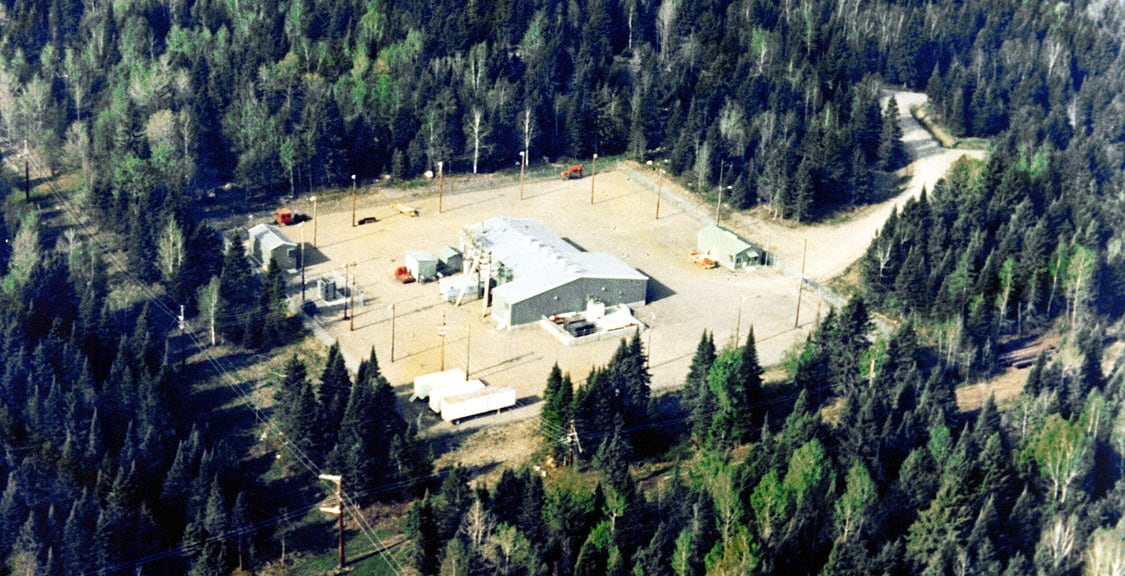COLUMBIA, Mo. — It was discovered nearly three decades ago. At the time, it was thought to be heavier than a blue whale, bigger than 23 football fields and more than 1,500 years old. The news of its discovery appeared in almost all the major media outlets and even made David Letterman’s Top 10 list.
In July 2018, in a preprint paper posted on bioRxiv, scientists studying it announced that the so-called “humongous fungus,” an individual of Armillaria gallica that lives in a forest in the Upper Peninsula of Michigan, is actually four times bigger and around one and a half times older than previously thought.
It's not just that it's so big and old. It's also about what "H.F.", as retired University of Missouri professor Johann Bruhn refers to it, can teach us. Bruhn has studied the Armillaria species for around 40 years as a research associate professor at Michigan Technological University first, and then at MU.
In the autumn, if it's not too dry, mushrooms pop up near a tree or grow from the stem. A person looking at one may think that there is nothing more to it. But that's not the case. A mushroom is just a piece of the puzzle — the "tip of the iceberg," so to speak, of a fungus.
The main "body" of most fungi — the part we don't usually see — is called the mycelium. One example is a fibrous or cottony growth that appears on fruit as it rots. Mycelium is composed of microscopic filaments called hyphae that look like tiny threads woven together, and in forests it mostly stays underground or within decaying wood.
So it lives unseen, until the time when it has enough nutrients and the weather is right for development of fruiting structures: mushrooms. As the mycelium exhausts nutrients from one food source, it grows outward seeking new ones. It usually expands as a ring that is known as a fairy circle. That's how separate mushrooms a couple of feet away may actually belong to the same fungus.
Fungi belonging to genus Armillaria act primarily as decomposers of roots of trees that are already under stress, as well as their stumps and fallen stems. Infected roots are no longer able to absorb water or nutrients, and so the tree gradually dies. By killing and decomposing stressed trees, the fungus makes room and nutrients available to healthier trees, thus serving as a sort of "gatekeeper".
Wood decayed by these species is white, and often spongy and wet. The mycelium of Armillaria is bioluminescent, especially in actively decaying wood. The bright white glow can be seen from a considerable distance and is commonly known as a fox fire. From one victim to the next, the fungus spreads by long black cords called rhizomorphs that develop from mycelium. These bootlace-like strands can travel great distances in search of a tree to infect and may form an extensive network. Shielded underground and in decaying wood, rhizomorphs are protected from high temperatures and drought.
That's not the case with mushrooms of Armillaria gallica. They have a pinkish-brown to reddish-brown cap and usually grow in late summer or during the fall. They are edible, but have to be cooked.
Armillaria gallica lives throughout much of forested North America, including in Missouri. Here, it may reveal to scientists how climate change could weaken even the most resilient trees. This could have implications for Missouri's economy and wildlife.
"So the average person walking through the woods would see clumps of mushrooms here, and they're separated by quite a distance often," Bruhn said. "And they think of it as being a small discrete organism with individual representatives scattered through the woods. And what we found was that, in fact, the Armillaria individuals in the forest floor are older than the trees. They're larger than the trees and they have incredible longevity."
One of the reasons for that longevity is its low rate of mutation. That, potentially, could improve understanding of the human genome and such diseases as cancer.

The discovery of the “humongous fungus” was a side product of a U.S. Navy effort called Project ELF.
The work began in 1982. The plan was to build miles-long antennae and bury their ends in the ground in Wisconsin and Upper Michigan. The antennae would send signals of extremely low frequency through bedrock to underwater craft around the world. The U.S. Navy conceived the project because it was having a problem: to receive an order, a submarine had to trail a buoy or buoyant antenna near the surface. Doing this made it easily detectable. The solution was to use the unique property of the radio waves: the lower their frequency, the more deeply they can penetrate the sea.
"So what they concluded was that they could send a very simple message through the water out to sea saying, 'Come to the surface to get new instructions' or 'Stay on the present course,'" Bruhn said. "Then the submarines wouldn't have to resurface so often or they wouldn't have to resurface at all."
The public was concerned about possible environmental impact, so the Navy established an elaborate environmental monitoring program to assess the effect of the electrical signals on wildlife, trees, etc. Bruhn was one of the participating scientists.
“So what we concluded was that what we had to do was we had to establish small plantations of a fast-growing tree species that was very genetically homogeneous so that all the trees would be the same age,” Bruhn told the Columbia Missourian . That would enable scientists to measure the trees and build a better statistical model of the effects of the electrical fields on their growth.

The researchers cut patches of mixed hardwood-conifer forest and planted red pines. As he expected, Bruhn soon noticed that two species of Armillaria were killing trees in the research plantations.
"The pine pathogen was focused on the pines, but there was this other species that came eventually known as the 'humongous fungus' that was decomposing the hardwood stumps," Bruhn said.
He observed that the Armillaria species seemed to occupy enormous territory. He wanted to understand how many individual organisms of each species were involved, and how they were spatially distributed in the forest.
He dug up the dead seedlings and cut a window through the bark to expose the fungus growing underneath and then sampled a piece of the fungus and grew it in culture. Then he mapped where the seedlings had been growing. Over about eight years, he ended up with a collection of hundreds of mapped cultures of the Armillaria species.
"One of the interesting things for me is that I cut the back of my finger, and I've got 10 stitches in it and the skin is going to grow back together because the skin on one side of the cut recognizes the skin on the other side of the cut as being compatible," Bruhn said. "Well, this mushroom can do the same thing."
When two cultures put in a petri dish belong to the same genetic individual they will grow together without leaving a sign that they were once separated. In distinct individuals, there would be a dark brown line between them. But to prove that different samples came from the same individual some molecular tests had to be done.
So Bruhn asked his friend Jim Anderson from the University of Toronto to help. Anderson had the necessary expertise in molecular biology and had a graduate student, Myron Smith, who just happened to be looking for a graduate project to work on.
They analyzed the samples, studied the rate at which the rhizomorphs (long black cords specific to Armillaria and related species that develop from mycelium — the main "body" of most fungi) grow and published a paper in Nature with the results in 1992. Soon, it got the name "humongous fungus."
RELATED

At that time, they determined that it occupied at least 37 acres, weighed more than 100 tons and by conservative estimates was more than 1,500 years old. The researchers were sure it was even larger than that. Starting in 2015, they took samples annually, mapped them, did compatibility tests to determine if they had reached the limit, and extended the geographic area of the study.
"We could hardly believe that it was as big as it turned out to be and we can only handle so many samples in the laboratory each year," Bruhn said. "This is a large perimeter to be making collections."
This year, they reached the edge. It turned out the humongous fungus weighed more than 400 tons and is more than 2,500 years old.
"We say 2,500 years, but that's a conservative guess. (It) could be almost as old as the forest that replaced the glaciers," Bruhn said. "What we wanted to understand was how the individual could get so large and so old and still retain its identity. For a human being, we would eventually contract cancer or something. People don't live to 2,500 years old. We wouldn't look like much."
The team also wanted to understand was where it originated. Typically, fungi start from a single point and grow outward in a radial pattern, but obstacles and the development of new food bases would cause them to change direction. By gathering the samples and analyzing the number of mutations, researchers understood more about both the longevity and the growth of the humongous fungus.
"It's a great follow-up on the work that they did quite a long time ago," said Thomas Volk, professor of biology at the University of Wisconsin-La Crosse. "The methods are much more sophisticated now, and I think they have been able to glean a lot more interesting information from the current study."
The team found that the fungus had very few mutations, and this could be the key to understanding how it has maintained its identity for such a long time.
"Cancers involve huge rates of specific mutations and Armillaria essentially represents the opposite end of the spectrum with just almost unbelievable genetic stability," Bruhn said.
So the question becomes, how does it do it?
"There may be a mechanism within the fungus that may be fixing mutations," Volk said, like a chemical, for example. "There is a possibility that something like that could help people to avoid mutations and mutations are really what cause cancer."
Living underground is another factor, besides genetic stability, that has contributed to its longevity.
Even healthy trees will have rhizomorphs wrapped around their roots "just waiting for a drought or an insect or epidemic or a fire or any kind of stress factor to weaken that tree and then it will infect it," Bruhn said.
One of the tree species Bruhn found to be resistant to the root disease Armillaria caused was white oak. But then he took a graduate student to a research site and saw a sign of Armillaria infection in an oak tree. "That was the first time ever that I had ever seen Armillaria doing to white oak what it's been doing to (black and scarlet oaks) for decades," Bruhn said.
RELATED

Simeon Wright was with Bruhn when they saw the white oak infected by Armillaria. Now a forest health specialist with the Michigan Department of Natural Resources, Wright said warmer temperature and increased heavy rainfall events over the past 30 years in Missouri could lead to increased periods of soil being saturated. That could make it difficult for roots adapted to drier conditions to get enough oxygen.
Conversely, warmer temperatures also increase drought at other times, which also damages roots. The tree becomes stressed and the Armillaria fungus can start attacking those roots. That can potentially lead to the change in the composition of the forest.
"If we see white oak replaced by species that are less valuable for timber or wildlife, that certainly could have a big impact on Missouri's economy," Wright said.
The sight of the enduring white oak dying from the root disease brought back Bruhn's memories of his senior year at Utah State University. He was taking a plant ecology course, and one day the professor came in and said: "You are too young to have seen this happen. You haven't lived long enough. We're in the early stages of being able to see what's changing. But I guarantee you that by the time you have retired, you will have seen changes you can't explain without including the greenhouse effect and climate change."
"He was right, boy was he right, and he was brave for bringing that up in 1970," Bruhn said.
Bruhn is a retired professor emeritus. He can’t answer all the questions that the discovery of the “humongous fungus” poses, but he hopes someone else will step in and carry on the work.





